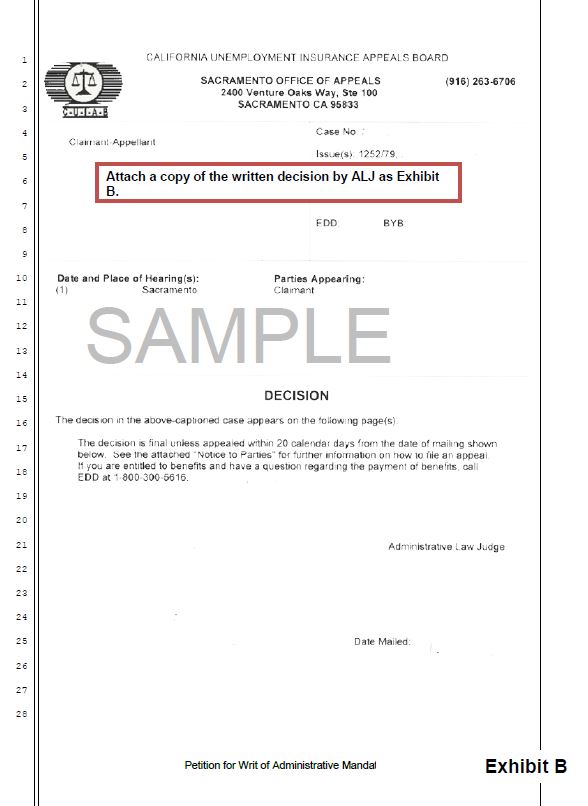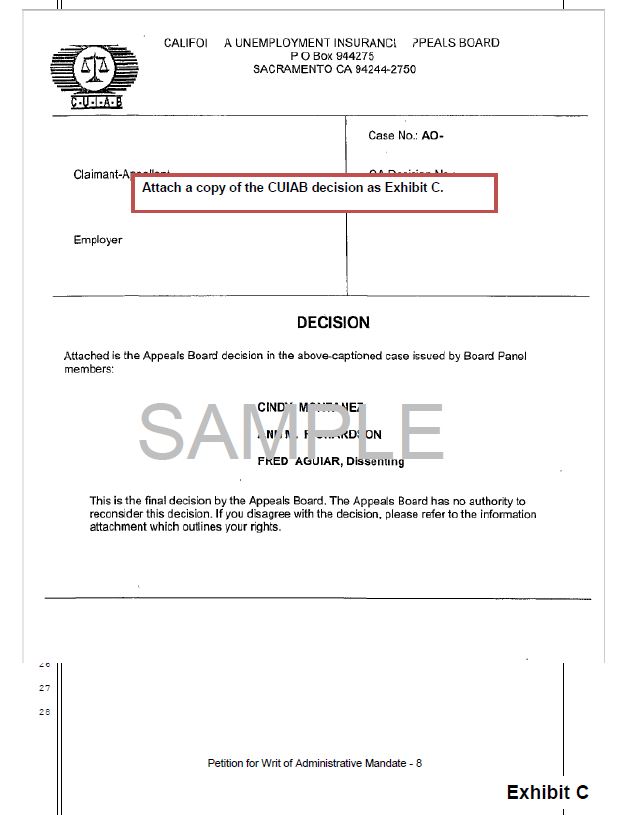Writ of Mandate for Unemployment Benefits
If you have been denied unemployment benefits, and have exhausted all of your administrative appeals, you may petition the court to review the denial of benefits by seeking a writ of administrative mandate (or mandamus), pursuant to California Code of Civil Procedure (CCP) § 1094.5.
Templates and Forms
- Petition for Writ (Unemployment) Template – RTF
- Notice of Hearing (Unemployment Writ) Template – PDF
- Civil Case Cover Sheet
- Proof of Personal Service (POS-020)
A petition for writ of administrative mandate is type of civil case. It is a request to have the court review the agency’s decision, and to issue a writ directing the agency to set aside its decision, reconsider its decision, or take some other type of action. You may not file this type of petition until you exhaust all administrative remedies.
To exhaust your administrative remedies in your unemployment insurance benefit case, you must have completed all of the following administrative steps:
- Filed for unemployment insurance benefits with the Employment Development Department (EDD)
- Been denied benefits by EDD
- Appealed the EDD’s decision within the limits stated on the denial letter (20 days)
- Attended a hearing before an administrative law judge (ALJ) to appeal the decision, and had the appeal denied by the ALJ
- Appealed the denial by the ALJ to the California Unemployment Insurance Appeals Board (Board) within the time limit specified on the decision (20 days)
- Had your final appeal denied by the Board.
You have only six months to file your Petition for Writ of Administrative Mandate from the date the California Unemployment Insurance Appeals Board mails you the notice of denial of the final appeal.
Your petition for a writ of mandate is not a new hearing or trial on the matter. Instead, the court reviews the administrative proceedings to ensure that the agency proceeded in accordance with the law, that you received a fair trial, and that there was not prejudicial abuse of discretion. Prejudicial abuse of discretion can mean that the agency did not follow the proper procedures, or that the agency’s decision is not supported by the evidence and findings. In most cases, the court must rely only on the evidence that was previously presented during the administrative hearing.
In its review, the court looks at decisions of law “de novo,” meaning that the court will make its own decision whether the correct laws were applied, whether they were applied correctly to the facts of the case, and whether proper procedure was followed.
The court will typically accept the factual findings of the administrative judge, unless the findings are not supported by substantial evidence. The judge hearing your writ of mandate request was not at the prior hearings to see the evidence that was presented, so they will presume that the ALJ who did see the evidence is better informed when deciding the facts of the case. For this reason, when challenging factual findings, the court will determine only whether an ALJ could have reasonably come to their factual conclusion based on the evidence that was presented.
Step by Step Instructions
1
Review the Decisions
Carefully review all decisions previously issued in your case. Since you are seeking to overturn these decisions, you will want to read them carefully to understand the reasons stated for the denial. You should ideally research the law as it relates to each basis stated for the denial, so that you may make an informed decision whether or not to seek a writ of mandate.
2
Reserve a Hearing Date for your Writ
In Sacramento, to obtain a hearing date for your writ:
Contact the assigned writ department to reserve an available date and time. Each writ department’s procedure for setting hearing dates is described online. Typically writs are heard on Fridays.
Prior to reserving the date, you should contact all opposing counsel (or self-represented parties) to determine a list of dates you would each find acceptable.
You will be required to file your brief at least 45 days before the hearing. Be sure that the date you reserve is far enough away to let you research, write, and file the brief on time.
3
Complete the Petition and Notice of Hearing
There is no standard Judicial Council form for the Petition for Writ of Mandate. Instead, the relevant documents must be typed on 28-line pleading paper. Customizable templates may be downloaded from these links:
At the end of this Guide is a sample Petition for Writ of Mandate and a sample Notice of Hearing for Writ of Mandate. Use these as models to draft your own versions.
You will also need:
Exhibits: You will need to attach a copy of each prior decision in your case to the Petition. Attach the EDD’s written Notice of Determination as Exhibit A, the ALJ’s written decision as Exhibit B, and the CUIAB’s decision affirming or reversing the ALJ as Exhibit C. Photocopy each decision and write its exhibit letter on the bottom of the first page. If an exhibit is longer than one page, number each page A‑1, A‑2, A‑3, and so forth.
4
Make Copies
Make two photocopies of each:
- Civil Case Cover Sheet (CM-010)
- Petition for Writ of Mandate (including the exhibits)
- Notice of Hearing for Writ of Mandate
Staple each of the copies, but leave the original unstapled so it can easily be scanned into the court’s file system.
5
File Your Documents
File your documents at the Gordon D. Schaber Courthouse at 720 Ninth Street in downtown Sacramento.
File the original and two photocopies of each document:
- Civil Case Cover Sheet (CM-010) (only the first page is required in Sacramento): original unstapled, plus two stapled copies.
- Petition for Writ of Mandate (with exhibits): original unstapled, plus two stapled copies.
- Notice of Hearing for Writ of Mandate: original unstapled, plus two stapled copies.
The filing fee is currently $435 filing fee to file a Petition for Writ of Mandate, unless your fees are waived. Current fees are available on the Sacramento County Superior Court’s website. If you qualify for a fee waiver, file the Request to Waive Fees (FW-001) and Order on Court Fee Waiver along with the petition. For more information, see the our guide on Fee Waivers.
When you file, the clerk will issue a case number and department for your Petition. The court will keep the original of each document, but will return the photocopies to you. In addition, the clerk will give you a number of informational documents, including a “Guide to the Procedures for Prosecuting Petitions for Prerogative Writs.”
6
Have Your Documents Served
Someone over the age of eighteen who is not a party in your case (not you) must personally serve the California Unemployment Insurance Appeals Board and the employer (“real party in interest” in the case), or the employer’s attorney, if represented. Your server must deliver these documents:
- Civil Case Cover Sheet
- Petition for Writ of Mandate (with exhibits)
- Notice of Case Assignment (provided by the court when you file);
- “Guide to Procedures for Prosecuting Petitions for Prerogative Writs” (provided by the court when you file).
The person who is serving your documents must complete a proof of service form, Proof of Personal Service (POS-020). For more information, see our guide on Proof of Personal Service.
Once the other parties have been served, file the original and two photocopies of the completed and signed Proof of Personal Service form(s) with the court. The court cannot issue any orders in the case until all responding parties have been timely served.
Next Steps
After completing the above steps, you must lodge the record of the CUIAB hearing in the court, research and write an opening brief, and attend the hearing, if necessary.
1
Request and Lodge the Administrative Record with the Court
The administrative record will contain all of the documents and orders filed in your Unemployment Insurance appeal. Send a written request to the California Unemployment Insurance Appeals Board that a copy of the administrative record be sent to the Superior Court, and a second copy to you. You will have to pay for the copies.
If your proceedings were officially recorded or had a court reporter, you may want request that a transcript of the hearing be created and lodged with the court if your argument depends in any way on what was said during your hearing.
The administrative record must be lodged with the court (the department assigned when you filed your petition) at least 25 days prior to your hearing. Consult the rules for the department hearing your writ for your judge’s preferences when lodging the record.
2
Research, Write, Serve and File Your Opening Brief
Since the burden is on the petitioner (you) to establish the legal grounds upon which you base your writ of mandate, you must serve and file an opening brief. The opposition can then serve and file an opposing brief. In response, you may then file a reply brief.
Because the legal issues in each brief are unique to a particular case, it is not feasible to include a sample brief with this Guide.
Remember the brief must be filed and served at least 45 days before the hearing.
- The opening brief must be served and filed at least 45 days before the hearing;
- The opposition brief must be filed at least 25 days before the hearing; and
- A reply brief (responding to the opposition) may be filed at least 15 days before the hearing.
Pursuant to Sacramento Superior Court Local Rule 2.26(D), the opening and opposition briefs are limited to 30 pages, while the reply brief is limited to 20 pages. The purpose of your brief is to make your legal argument in favor of granting your request. As such, an opening brief should include an introduction, a summary of the procedural history of the case, and a legal argument in favor of your request for each of the mistakes you allege that the trial court made.
When your brief is complete, have your server mail it to the other parties and sign a Proof of Service by Mail (POS-030). File the brief (original plus two copies) and POS-030 in court by the deadline.
3
Check Tentative Ruling and Request Appearance if Needed
Pursuant to Sacramento Superior Court Local Rule 1.06, the court will make a tentative ruling on the merits of your writ by 2:00 p.m. the court day before the hearing. You may read the tentative ruling online, or you may call the clerk for the department assigned to your writ to have them read it to you. For more information, see the Sacramento County Superior Court’s website.
Review the tentative ruling very carefully. If you are not happy with the tentative ruling, and wish to present arguments in front of the judge, you must call all opposing counsel (or self-represented parties), as well as the clerk for the department assigned to your writ, no later than 4:00 p.m. the court day before your hearing and state that you are requesting oral argument.
If neither you nor the opposing counsel or self-represented party requests oral argument, the court will simply make the tentative ruling the order of the court, and no oral argument will be permitted.
4
Attend the Hearing
If you or the opposing counsel or self-represented party request oral argument, be sure to attend the hearing. The court will consider the merits of your request at the hearing.
The judge has a great deal of discretion as to how he or she wishes to conduct the hearing. The burden is on you, the petitioner, to convince the court to grant your petition, so typically the petitioner will be permitted to speak first.
Keep in mind that the judge has likely read the briefs of all parties, so it is important to listen carefully to any guidance the judge might provide as to whether he or she wants the entire matter argued, or only wishes oral argument on specific points.
5
Prepare Your Judgment and Writ
If you win your petition, you will be directed to create a formal judgment granting your writ, as well as the writ of of mandate itself. The judgment should mirror the language that the court used in the minute order, while the writ should mirror the relevant language in the judgment. When creating signature lines, please note that the judgment is signed by the judge, while the writ is signed by a deputy clerk.
Samples of the format for each are available in California Administrative Mandamus, at sections 15.39 and 15.41, respectively.
For More Information
On the Web:
Guide to the Procedures for Prosecuting Petitions for Prerogative Writs
A summary of the writ procedures used in the Sacramento County Superior Court created by the court.
In the Law Library:
California Administrative Mandamus KFC782 .C34
Electronic Access: On the Law Library’s computers, using OnLAW.
California Forms of Pleading and Practice KFC1010 .A65 C3. Vol 41A.
Electronic Access: On the Law Library’s computers, using Lexis Advance.
California Practice Guide. Administrative Law KFC780 .A975
Samples
Petition for Writ of Mandate







Notice of Hearing


This material is intended as general information only. Your case may have factors requiring different procedures or forms. The information and instructions are provided for use in the Sacramento County Superior Court. Please keep in mind that each court may have different requirements. If you need further assistance consult a lawyer.




